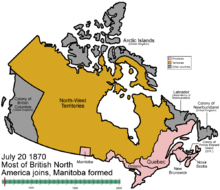Manitoba Act
The Manitoba Act was passed by the Canadian Parliament on May 12, 1870. When it came into force on July 15 of the same year, the national territory of Canada was significantly expanded and the province of Manitoba was created within the expansion area. The Manitoba Act is part of the Canadian Constitution to this day.
prehistory
The Canadian Dominion , formed in 1867 from the province of Canada (now Ontario and Québec ), Nova Scotia and New Brunswick , bought in 1869 from the Hudson's Bay Company (HBC) the vast areas known as the Northwest Territories and Ruperts Land in the northern and central parts of what is today Canada.
The new areas "belonged" to Canada, but were not yet politically integrated. To prepare for integration, surveyors were sent to the only major settlement area, the Red River District , which formed the area around today's provincial capital of Manitoba, Winnipeg . This then triggered the Red River Rebellion under the Métis Louis Riel among the local population, the Métis (descendants of French and British fur traders and Indian women) and some Scottish and German Presbyterian settlers , as they feared for their land rights.
As a result, the HBC laid down the interim administration of the Red River settlements. The land survey had previously been interrupted in the wake of the rebellion. At the end of 1869, the Métis founded a provisional provincial government seeking admission to the Canadian Dominion, and Riel became its president. This was followed by talks between the new administration and envoys from the Canadian Dominion. At the same time, some Anglo-Canadian new settlers rebelled against the Métis government. Most of the conflicts were settled, but the racist rebel Thomas Scott was most recently executed on legally dubious grounds.
The Métis and the envoys were finally able to agree on a list of demands for a new province within the Dominion, and this was presented by a delegation in the capital, Ottawa . The delegation was arrested at first, but was soon released and invited for talks. Agreement was largely reached on the new province of Manitoba, but the amnesty for the Red River rebels, who now formed the Métis government, was postponed, not least because of Scott's execution.
Contents of the law
- The Northwest Territories and Rupert's Land become part of the Canadian Dominion
- The province of Manitoba in an area around today's Winnipeg is created and its boundaries are determined (much smaller than today's Manitoba)
- The number of Manitoba's members in Canada's Senate and Parliament (House of Commons) is determined
- Manitoba's right to vote is enshrined
- The legislative Manitoba is defined
- (Upper) Fort Garry , now a district of Winnipeg, is declared the provincial capital
- English and French are made official languages
- Responsibilities for taxes, administration and infrastructure are defined
- The recognition of land ownership is regulated, the Métis are awarded in § 31 5700 km² (1.4 million acres ).
- The remaining areas of Northwest Territories and Rupert's Land are to be co-administered by the Governor of Manitobas under the name of Northwest Territories
Aftermath
After the founding of the province of Manitoba on the basis of the Manitoba Act, Riel was elected several times for the province in the Canadian parliament, but was never able to take up the mandate because he was still denied an amnesty for the Red River Rebellion. The Métis could otherwise benefit little from their new rights. Their livelihoods were in equal parts agriculture and buffalo hunting . The buffalo were nearly wiped out in the 1870s, so they left their country and followed the remainder west into what is now the province of Saskatchewan . When the hunt was no longer profitable there either, they called Riel from his exile in the USA, who led them in the Northwest Rebellion in 1885 , which failed. Riel was executed for high treason that same year.
In 1881 the area of Manitoba, meanwhile ridiculed as a postage stamp province, was significantly enlarged with a further resolution. It reached its current extension to Hudson Bay with the largest expansion in 1912.
Web links
- Text of the Manitoba Act, 1870 (English)
- Manitoba border Extension Act, 1881 (Engl.)
